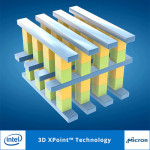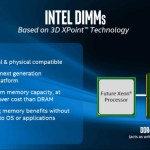In this podcast, the Radio Free HPC team looks at the Top Technology Stories for High Performance Computing in 2015. “From 3D XPoint memory to Co-Design Architecture and NVM Express, these new approaches are poised to have a significant impact on supercomputing in the near future.” We also take a look at the most-shared stories from 2015.
Video: Intel 3D XPoint Technology
In this video from the Disruptive Technologies Session at the 2015 HPC User Forum, Intel’s Ralph Biesemeyer presents: Intel 3D XPoint Technology.
“For decades, the industry has searched for ways to reduce the lag time between the processor and data to allow much faster analysis,” said Rob Crooke, senior vice president and general manager of Intel’s Non-Volatile Memory Solutions Group. “This new class of non-volatile memory achieves this goal and brings game-changing performance to memory and storage solutions.”
Video: First Look at Intel Optane Non-volatile Memory
“At IDF, Intel introduced Intel Optane technology, which is based on the revolutionary 3D XPoint non-volatile memory media and combined with the company’s advanced system memory controller, interface hardware and software IP, to unleash vast performance potential in a range of forthcoming products. Intel Optane technology will first come to market in a new line of high-endurance, high-performance Intel SSDs beginning in 2016. The new class of memory technology will also power a new line of Intel DIMMs designed for Intel’s next-generation data center platforms.”
Radio Free HPC Looks at 3D XPoint Non-Volatile Memory
In this video, the Radio Free HPC team looks at the newly announced 3D XPoint technology from Intel and Micron. “3D XPoint ushers in a new class of non-volatile memory that significantly reduces latencies, allowing much more data to be stored close to the processor and accessed at speeds previously impossible for non-volatile storage.”
Intel and Micron Announce 3D XPoint Non-Volatile Memory
Today Intel Corporation and Micron Technology unveiled 3D XPoint technology, a non-volatile memory that has the potential to revolutionize any device, application or service that benefits from fast access to large sets of data. Now in production, 3D XPoint technology is a major breakthrough in memory process technology and the first new memory category since the introduction of NAND flash in 1989.






